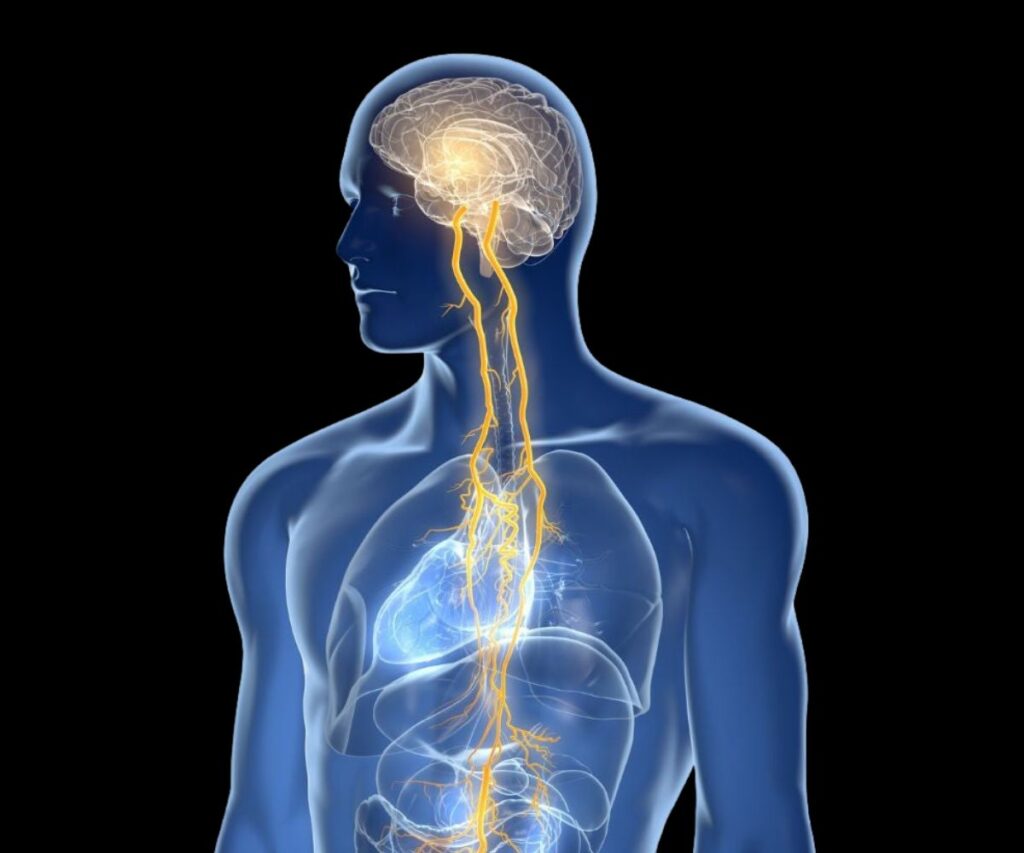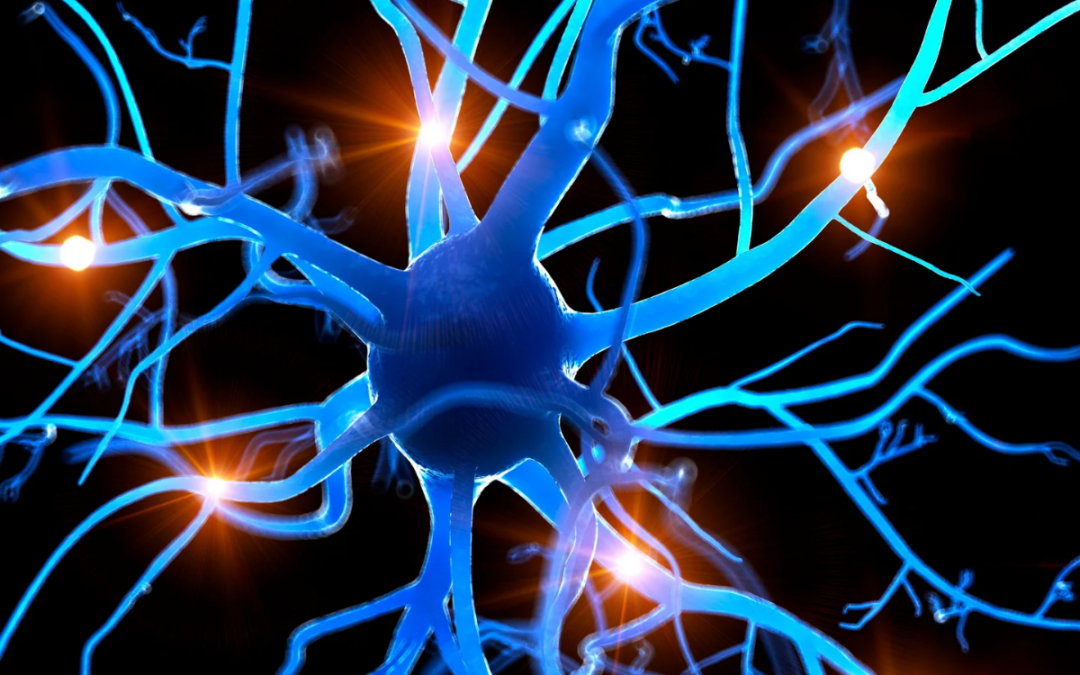If I were handing out awards for the most fascinating body part, the vagus nerve would most likely win, hands down. (Or, perhaps more appropriately, hands relaxed—because that’s just one of the things the vagus nerve helps with.) This unsung hero of the nervous system is your personal chill-out button, gut-health guru, heart-rate whisperer, and even mood booster. And the best part? You can in fact train it to work even better!

What (and where) is this magical vagus nerve?
Let’s start with the basics. The vagus nerve—its name comes from the Latin word for “wandering”—is the longest cranial nerve in your body, and wow, does it live up to its name. It starts in your brainstem and meanders all the way down through your neck, heart, lungs, digestive organs, and even into parts of your intestines. Imagine it like your body’s own Wi-Fi network, constantly sending and receiving signals between your brain and your organs, keeping everything running smoothly.
And it’s not just about logistics. The vagus nerve is the superstar of the parasympathetic nervous system (more on that in a second), which means it’s the key player in helping you stay calm, breathe deeply, digest your food, and generally not feel like a ball of stress. Pretty amazing, right?

Clearing up a common vagus nerve myth
I’m not sure where the myth started, but there’s some incorrect info floating around that suggests we have only one vagus nerve. Nope! Definitely not so. Just like almost everything else in our bodies, our vagus nerve system is bilateral—we have one on the left side and one on the right. Each originates from the medulla oblongata in the brainstem and descends through the neck within the carotid sheath, nestled between the internal carotid artery and the internal jugular vein. (TMI? OK, just know that it runs down your neck, on both sides.) Our bodies were cleverly designed with mirrored structures for a reason: backup! Having two vagus nerves ensures redundancy, so if one side is damaged, the other can still help regulate vital autonomic functions, like heart rate, digestion, respiratory rate, and stress response. So, the next time you hear someone say we have only one vagus nerve, you can gently let them know we’ve got two of ‘em. (But be kind! Nobody likes a know-it-all,)
One extra fact from Nerd Department Central (that’s me): All mammals possess a bilateral vagus nerve system, and it also exists in other vertebrates, including birds and reptiles!

Evolutionary history: How did we get this amazing nerve?
Now, if you’re like me, you might be wondering—why do we even have a vagus nerve? Where did this awesome relaxation switch come from? Well, it’s been around for millions of years, fine-tuning itself as vertebrates evolved.
Back in the day, when our early mammalian ancestors were trying to avoid being eaten, they needed a way to switch quickly between high stress, “Oh no, a predator!” mode and low stress, “Whew, time to digest that delicious leaf” mode. Enter: the vagus nerve, helping ancient creatures recover from danger and conserve energy for when it was actually needed. Fast forward to today, and it’s still doing that same job—except now, the “predator” is your overflowing email inbox, and “digesting a leaf” is figuring out what’s in the fridge for dinner.

The sympathetic vs. parasympathetic nervous systems: A tug of war
Picture this: You’re walking in the woods, and suddenly, a bear appears. (OK, maybe you’re just opening a stressful email at work, but stay with me.) Your body instantly goes into fight-or-flight mode. Your heart races, your breathing quickens, and your digestive system slams on the brakes—because who has time to digest when survival is on the line?
That’s your sympathetic nervous system (SNS) kicking in. It’s the system responsible for keeping you alive in dangerous situations, preparing you to either fight, flee, or freeze.
Now, once the “bear” (or your boss’s email) is gone, you need to calm down and recover. That’s where your parasympathetic nervous system (PNS) comes in, and guess what? The vagus nerve is the star player here. It sends signals to slow your heart rate, deepen your breathing, and bring digestion back online. Essentially, it reassures your body, “Crisis averted, and we can calm down now.”

Why should you care? The benefits of a healthy vagus nerve
A well-functioning vagus nerve isn’t just a nice bonus—it’s a total health game-changer. Here’s what happens when your vagus nerve is in tip-top shape:
- Lowers stress and anxiety: Your vagus nerve releases neurotransmitters like acetylcholine (ACh) and gamma-aminobutyric acid (GABA), which literally help you relax. (If enough readers show interest, I might do a future article on these two amazing neurotransmitters—super fun stuff!)
- Improves digestion: Ever had your stomach shut down from stress? The vagus nerve gets digestion moving again when it’s time to rest and refuel.
- Boosts mood and emotional resilience: A well-tuned vagus nerve helps produce feel-good chemicals like serotonin and dopamine.
- Supports heart health: It helps keep your heart rate steady and your blood pressure in check.
- Reduces inflammation: Your vagus nerve sends signals that fight off inflammation, which is linked to tons of chronic diseases.
- Enhances social connection: Studies show that better vagal tone improves our ability to bond with others—so yes, strengthening your vagus nerve might even help your relationships!

How to stimulate and strengthen your vagus nerve
So, how do you get your vagus nerve to work better? Thankfully, it’s easier than you might think. Here are some fun, science-backed ways to train your vagus nerve so it helps you relax and function at your best:

- Deep breathing: Try inhaling for 4 seconds, holding for 4 seconds, and exhaling for 8 seconds. Longer exhales activate the vagus nerve and tell your body to chill out.
- Cold exposure: Splash your face with cold water or take a cool shower—yes, it’s a bit uncomfortable, but it wakes up your vagus nerve in the best way.
- Singing, humming, or chanting: Ever noticed how amazing you feel after belting out a song in the car? You’re giving your vagus nerve a literal tune-up! (Your vagus nerve is positively stimulated by your vocal cords—so cool.)
- Meditation and mindfulness: Slowing down your thoughts and focusing on the present moment is a direct vagus nerve boost.
- Laughter: Seriously, laugh more! It stimulates the vagus nerve and improves heart rate variability (a marker of good vagal tone).
- Gargling: I know, I know—it sounds weird. But gargling water works to activate the vagus nerve. (Note: The research shows that to achieve maximum benefit, you need to gargle for approximately 10 seconds or longer.)
- Yoga and Tai Chi: These movements encourage deep breathing and relaxation, both of which improve vagal tone.
- Probiotics: A happy gut means a happy vagus nerve. Foods like yogurt, kimchi, and sauerkraut support a healthy gut microbiome. (Note: Recent studies on probiotics contraindicate taking them in pill form. Best to stick with natural probiotics, like the ones I’ve listed.)

The takeaway: Vagus, Baby! (I was just waiting to deliver that punchline…)
If you’ve ever wished you had a built-in relaxation button, good news: you already do! Your vagus nerve is your body’s secret weapon for staying calm, healthy, and resilient. The best part? You can train it to work better by using simple techniques like deep breathing, humming, or even laughing.
So, next time you’re feeling frazzled, remember: you’ve got a hidden superpower inside you, just waiting to be activated. Take a deep breath, splash some cold water on your face, and thank your vagus nerve for being the ultimate mind-body connection. Cheers to staying calm, connected, and in control!


